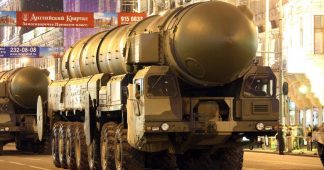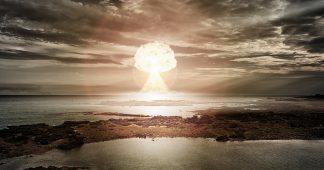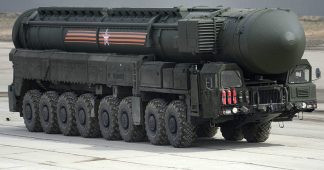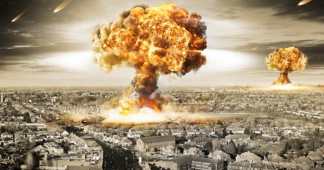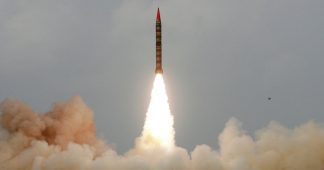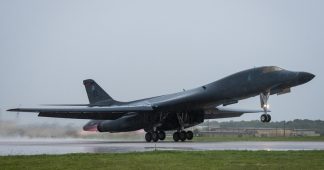By T.J. Coles
Global Research, November 22, 2017
The British Ministry of Defence (MoD) has published several reports over the last few years. They discuss geopolitics and related themes, one of which is the likelihood of nuclear war or accident, including what it means for long-term survival.
Experts say that even a so-called limited exchange or accident would be catastrophic. For example, a recent paper in Earth’s Futurecalculates that the most optimistic scenario of a “small,” regional nuclear war between India and Pakistan would wipe out millions of people through famine and result in a nuclear winter. An exchange between the USA and Russia, for instance, could be even bigger and more devastating.
America’s ongoing “Asia Pivot” encourages China to build up its arsenals. Proxy wars in Syria and Ukraine with Russia and continuing tensions with North Korea also increase the risk of brinkmanship and miscalculation between those nuclear powers.
Britain’s Role
By training rebels in Syria and armed forces in Ukraine, the UK is particularly responsible for contributing to escalating tensions. Britain remains one of the USA’s closest allies and enjoys a “special relationship” with the US. It serves as a proxy for US Trident nuclear weapons systems. The UK’s Vanguard submarines host US-supplied Trident II D5 Intercontinental Ballistic Missiles. In 2016, a dummy ICBM was launched by the UK at a test target off the coast of Africa. It self-destructed and headed for Florida, according to news reports. The event took place a time when the British government voted to upgradeTrident in violation of Britain’s Non-Proliferation Treaty obligations and at a time when the newly-appointed Prime Minister, Theresa May (not yet elected), answered “Yes,” when asked by a member of Parliament if she would launch a nuclear missile and kill hundreds of thousands of civilians.
Let’s look at some examples of the UK MoD’s admissions that: 1) the world is getting more dangerous, 2) it is likely that some states will use nuclear weapons at some point, 3) brinksmanship increases the risk of miscalculation, and 4) that such events threaten human existence. These admissions are startling for a number of reasons: the MoD possesses nuclear weapons, yet acknowledges their danger; the media fail to report on these matters, despite their coming from establishment sources; and governments are not inherently compelled by this information to de-escalate.
“Doomsday Scenarios.”
Every few years, the MoD updates its studies concerning the nature of global developments. The third edition of the Strategic Trends Programme predicts trends between the years 2007-2036. It states (MoD’s emphases):
Accelerating nuclear proliferation will create a more complex and dangerous strategic environment, with the likely clustering of nuclear-armed states in regions that have significant potential for instability or have fears about foreign intervention. For example, North Korean, Pakistani and potentially, Iranian nuclear weapon capability will increase significantly the risks of conflict in Asia if a system of mutual deterrence does not emerge. In addition, nuclear possession may lead to greater adventurism and irresponsible conventional and irregular behaviour, to the point of brinkmanship and misunderstanding. Finally, there is a possibility that neutron technologies may reemerge as potential deterrent and warfighting options.
Neutron weapons supposedly kill living things but do not harm property. The report also notes a potential “revival of interest” among “developed states” in “neutron and smarter nuclear technologies.” Neutron bombs could become “a weapon of choice for extreme ethnic cleansing in an increasingly populated world.” The document concludes rather casually, stating: “Many of the concerns over the development of new technologies lie in their safety, including the potential for disastrous outcomes, planned and unplanned.” Note the word planned. It goes on to say: “Various doomsday scenarios arising in relation to these and other areas of development present the possibility of catastrophic impacts, ultimately including the end of the world, or at least of humanity.”
Will the US or Israel get impatience and attack Iran or North Korea? The now-archived Future of Character of Conflict (2010) predicts trends out to 2035 and states:
The risk of Chemical, Biological, Radiological and Nuclear (CBRN) use will endure; indeed increase, over the long term. The strategic anxiety and potential instability caused by CBRN proliferation is typified by international frustration over Iran and North Korea, with the risks of pre-emptive action and regional arms races, and where soft power alone has not been notably successful.
Soft power refers to economic and diplomatic coercion. As the US expands its global reach, other countries might seek possession of nuclear weapons to deter the USA: “[t]he possession of nuclear weapons, perceived as essential for survival and status, will remain a goal of many aspiring powers.”
Unless enforcement mechanisms are imposed, will arms controls and treaties be effective? Out to the year 2040, says the MoD’s fourth edition of its now-withdrawn Strategic Trends Programme, “[t]he likelihood of nuclear weapons usage will increase.” It goes on (MoD’s emphases):
Broader participation in arms control may be achieved, although this is unlikely to reduce the probability of conflict. Effective ballistic missile defence systems will have the long-term potential to undermine the viability of some states’ nuclear deterrence.
Could that last statement refer to ICBMs being integrated into a so-called defense shield and used by the few countries that possess them against ones that do not? What is the likelihood of nuclear weapons being used for warfighting? Finally, Future Operating Environment 2035 states:
Some commentators believe it is increasingly likely that a range of state actors may use tactical nuclear weapons as part of their strategy against non-nuclear and conventional threats coming from any environment, severe cyber attacks. Limited tactical nuclear exchanges in conventional conflicts by 2035 also cannot be ruled out, and some non-Western states may even use such strikes as a way of limiting or de-escalating conflict.
Conclusion
These analyses and admissions on behalf of the UK MoD and its reliance on US-produced weapons systems should serve as enough of a warning to scholars and anti-nuclear weapons campaigners to suggest that, as long as weapons of mass destruction exist and as long as international treaties have no enforcement mechanisms with regards the powerful countries, the clock to midnight will continue ticking.
* Dr. T. J. Coles is director of the Plymouth Institute for Peace Research and the author of several books, including Voices for Peace (with Noam Chomsky and others) and the forthcoming Fire and Fury: How the US Isolates North Korea, Encircles China and Risks Nuclear War in Asia(both Clairview Books).
